Fantasy in armor. From the Pavezi tank fighter to the Kiska APC
О tanks with love. Looking at the tanks, both serial and experimental, one cannot but be surprised at the creative imagination of their authors and at the same time their ... stupidity, that they did not see the obvious and at the same time rose in their creative impulse to true genius. Or, on the contrary, they reproduced pattern after pattern in the hope that people in uniform would choose at least something. And you don't have to go far for examples: here they are, right in front of you, in the next issue of our freak show.
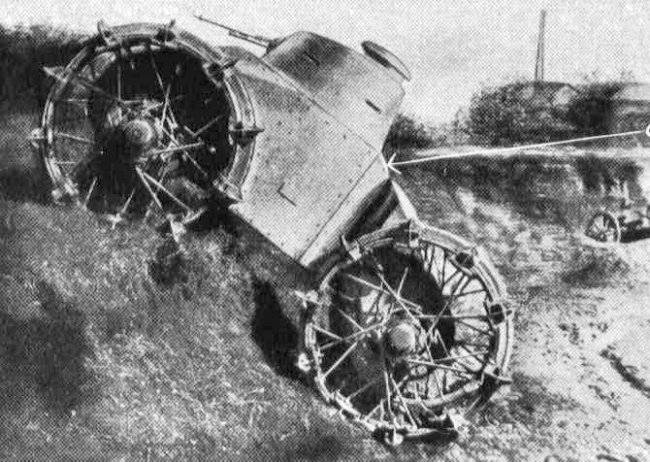
Pavezi P4 tank - the first prototype with wheels with a diameter of 1200 mm, 1924
And we will start it with stories about how in 1919 the Italian engineer Hugo Pavezi preoccupied himself with the idea of increasing the patency of wheeled vehicles and decided to create such a wheeled all-terrain vehicle. A wheel diameter of 1,2-1,3 meters would allow her to easily roll through ditches and ditches. But Pavezi seemed to have little big wheels. He decided to make all-wheel drive wheels, and in order to reduce their weight, he chose a bicycle-type design in which a narrow rim would be attached to the hub on spokes from a steel bar. The tires were supposed to be solid, like a rubber band in tanks. But that was not all: the Pavezi car relied on these "tires" only when driving along the highway. On poor roads, narrow tires buried in the ground, and the wheels began to rely on metal rims, which were about three times wider than tires. So was arranged, for example, the chassis of the artillery tractor Fiat-Pavesi P4-110. And since the grip on the smooth wide rim with the ground was poor, the designer provided special “claws” on wheels. They were located around the perimeter of the wheel and could rotate 180 degrees around its axis, and thus turn into effective lugs.
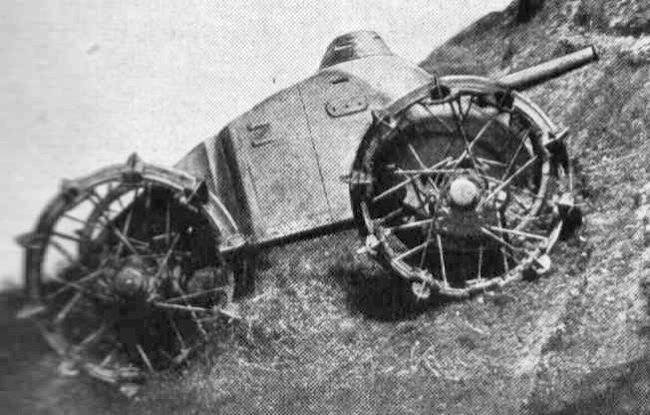
Pavezi P4 - “tank destroyer”, 1925. Photo from the Heigl handbook
However, not even these amazing wheels were the highlight of the construction of the Pavezi all-terrain vehicles, but the arrangement of their frame. It was a “breaking type” and consisted of two carriages connected by a hinge joint. The turn of such a machine was carried out not by changing the position of the front wheels, but by the entire half of the frame. Thanks to this, the turning radius was only 6 meters, and the tractor itself turned out to be extremely maneuverable, although the connection of the halves of the machine and the cardan transmission system on it turned out to be quite complicated.
All-terrain vehicles of Pavezi, as they say, “went”, and then it occurred to the designer to create a wheeled tank on his chassis. The first sample, which received the P4 index, began to be tested already in 1924. In terms of driving performance, it was not inferior to light Italian tanks FIAT 3000 mod.21 and surpassed the French Renault FT-17. The weight of the tank was 4200 kg, and its maximum speed on solid ground was up to 20 km / h. All of his wheels were driving, so the P4 could overcome a ditch 1,2 meters wide, took a vertical wall up to 1 meter high and also had excellent maneuverability - it could turn around literally on a patch!
Surprisingly, the military did not like this car, unlike the high-wheeled tractor. Then the designer presented an analogue version of P4 with wheels with a diameter of 1,55 meters, but only armed with a 57-mm gun located in the frontal sheet of its body. To monitor the terrain, the commander, who also served as the driver, was served by a cylindrical wheelhouse with viewing slots. The shooter, who was also loading, was the second crew member. The length of the tank was 4240 mm, width - 2180 mm, height - 2060 mm, clearance - 750 mm. With a total combat weight of 5500 kg, the tank developed a maximum speed of 24 km / h on the highway.
True, the designer himself did not call his car a tank. In the famous Heigl handbook, Taschenbuch der Tanks, published in Munich in 1935 and then reprinted in the USSR in 1937, it was called the Pavezi High-Wheel Tank Fighter. And yes, indeed it could well be called so, since his 57-mm long-barreled gun could well penetrate the armor of any European tank except the French FCM 2C in those years.
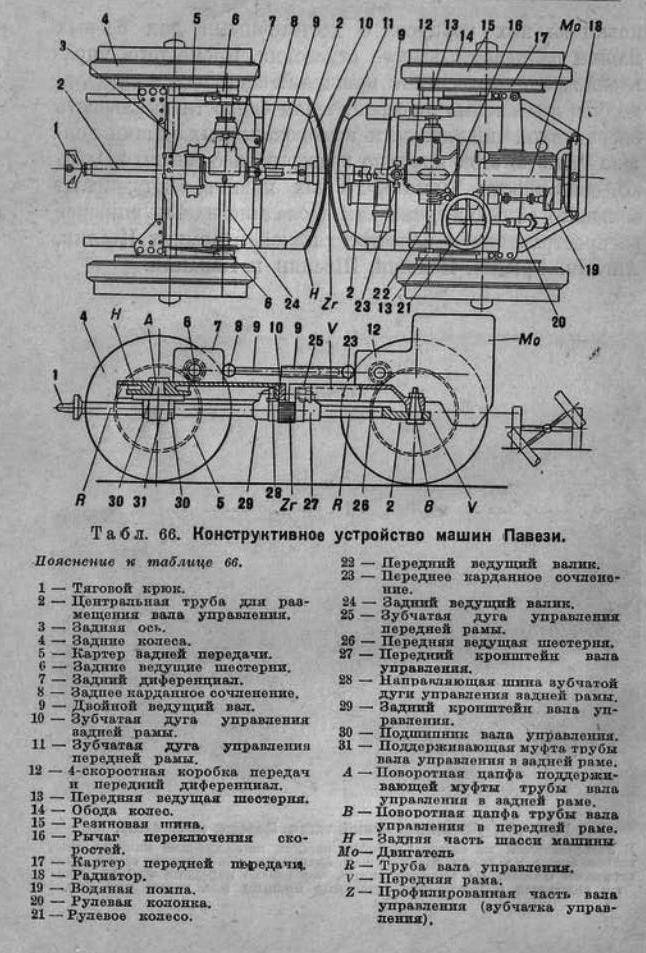
Schematic diagram of the device chassis Pavezi. Page from the Heigl handbook
The Italian military did not like the third model with a more powerful engine, increased armor thickness and even larger diameter wheels. The maximum speed of this car has increased to 35 km / h. But this model did not go into mass production, so the Italian tanks remained purely tracked. Perhaps the military felt that the vulnerability of the Pavezi wheels would be too great, and the wheels themselves, and the undercarriage, too complex for the tank. Although transport vehicles of this type did not cause any complaints from them and were actively used primarily in the army.
And here, as it happens very often, Pavezi got imitators in Italy. Rather, a copycat who adopted his ideas. And, apparently, he decided: “It did not work out for him, it will work out for me!” This person turned out to be the head of the Ansaldo firm Giovanni Ansaldo, who liked the Pavezi P4 artillery tractors so much that he decided to do something similar, but in his own way. That is, Pavezi Ansaldo did not completely copy the scheme, although he also decided to make the tank on high wheels.
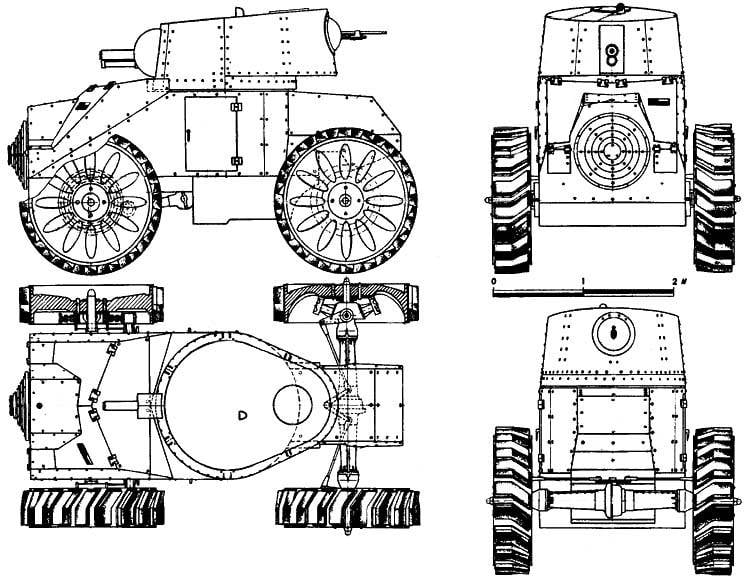
Four projections of the Ansaldo heavy wheeled tank model 1929
His wheels had a diameter of 1500 mm and a width of 400 mm and had developed spur-lugs made of rubber molds on the rims, which provided the machine with good cushioning. He made the rear axle a T-shape, fixed so that it could tilt 30 ° to each side of the horizon, which, in turn, ensured a constant fit of the wheels to the ground even if the ground was very uneven. In this case, the axis was a crankcase for the rear differential and transmission of the rear wheels, which could be rotated 40 ° to rotate the machine in the horizontal plane. That is, the car had steering wheels at the rear, but it was all-wheel drive. At the same time, its four-speed gearbox had three speeds forward and one back.
The engine was a gasoline 4-cylinder rated at 110 hp. with liquid cooling, which was a step forward compared to Pavezi machines, which were only 30-45-horsepower “engines”.
The thickness of the armor, mounted on rivets, ranged from 6 to 16 mm and had fairly rational angles, although many of its sheets were still mounted vertically. The entrance to the tank was a rectangular door on the left side. A pump was provided in the tank for pumping out water that got inside and protection against toxic gases, which was carried out by creating excess pressure inside the tank.

However, he was ahead of his time and “didn’t go anywhere” and this air-cushioned armored car of the famous Soviet designer P. Gorokhovsky, whose fate was very sad. He survived 1937, but was still arrested in 1942 and shot in 1943!
The armament of the tank compared to other Italian armored vehicles was very strong: a 37 mm gun (front) and a 6,5 mm Fiat machine gun of 1914 model (in the rear of the turret in a ball mount), and it could be removed and used as anti-aircraft, and shoot through a small hatch on the roof of the tower. The observation was carried out through the viewing slits and using the optical sight of the guns. The crew consisted of three people: a driver, a gunner (he is a commander) and a machine gunner of a stern machine gun (he is also loading a gun).
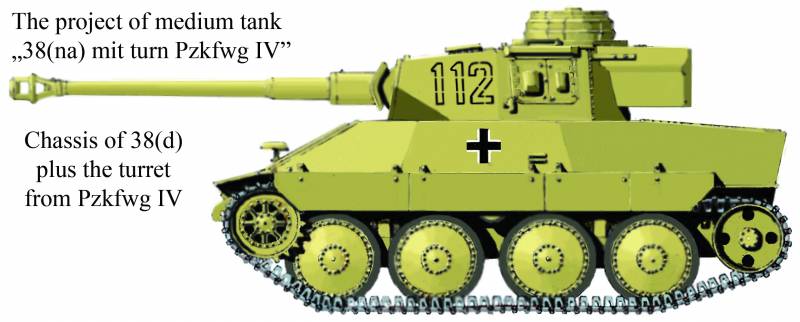
It is interesting that only by this time, namely by October 1943, the German designers of the Krupp company thought of putting a tower from the Pzkfwg IV on the chassis of the Czech tank 38NA. And they got a very good tank, something similar to the earlier T-34s, but better armed. It could be produced in much larger quantities than the standard Pzkfwg IV, but ... something prevented, and this tank neither in 1943, nor in 1944, nor in 1945 saw the light!
Since the weight of the tank was not so small - 8250 kg, in most sources of that time it was called "heavy wheeled tank". And although it was really built, tested and showed a speed of 43,5 km / h (which was very good for 1929), it also freely crossed a vertical wall 1 meter high, a trench of 1,2 m, and a steep slope of 45 ° the army never accepted it.
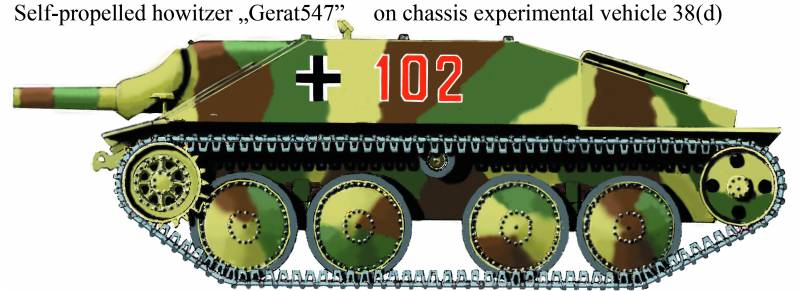
We all know the German Hetzer self-propelled guns well, but the 38t chassis has become the basis for an amazing amount of the most unusual projects, including the improvement of this vehicle. Before us is the project of the 105-mm howitzer Gerat547 38 (d)
Well, if he had accepted, and would he have established himself well in the same Abyssinia or during the Civil War in Spain? Then the whole history of world tank building could well have gone a little differently. Could ... but I didn’t go!
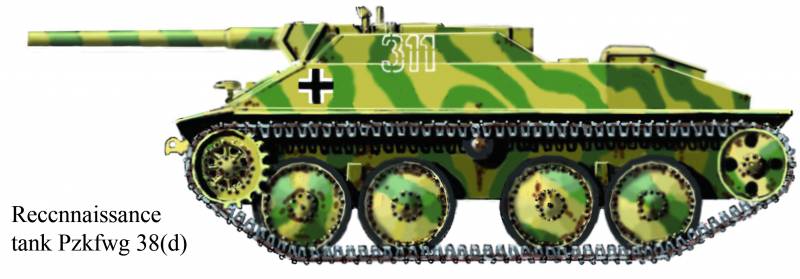
And this is a reconnaissance vehicle based on the Hetzer, only without a roof, to become even lower, but with the same weapon!
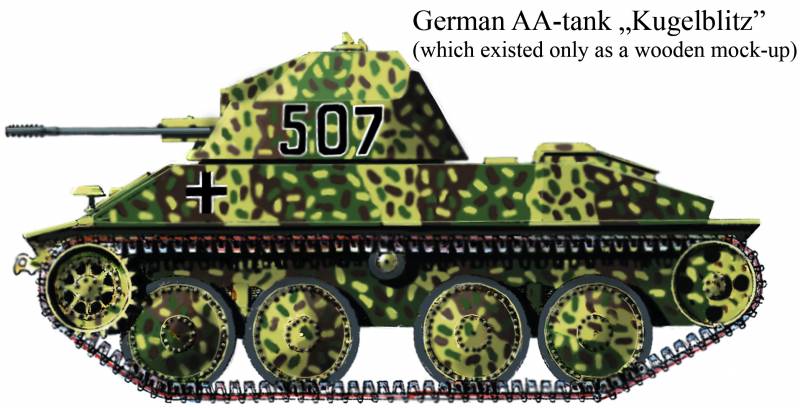
Well, to make this car in metal is simply no success, but managed to finish its wooden model. At the end of the war, the Germans were very annoyed by the low-flying English and American Tempest and Thunderbolt aircraft, armed with missile pendants. It was assumed that such "anti-aircraft guns" based on tanks, armed with a pair of 30-mm automatic guns, will be able to fight them effectively!
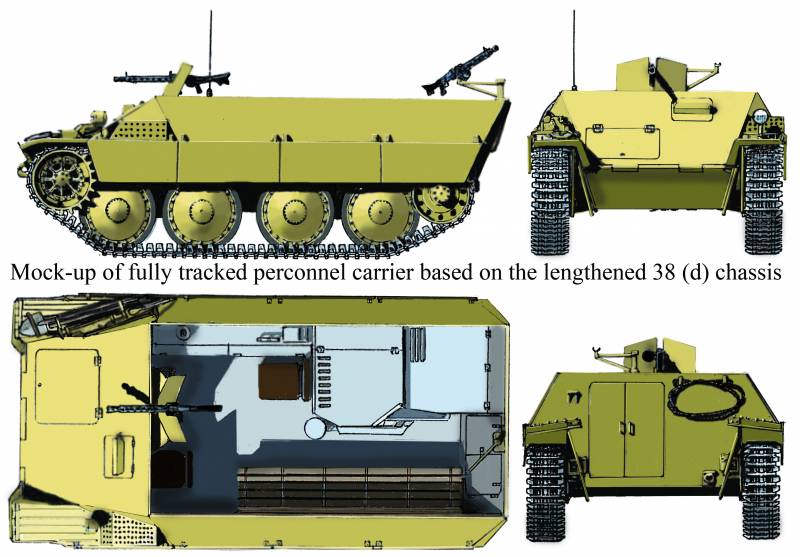
Again, a wooden model of this armored personnel carrier planned for release was made. And the question is? Why release smaller armored personnel carriers losing the war, when, winning it, do you release large armored personnel carriers? The Germans had a whole series of armored personnel carriers Sd Kfz 251, on the basis of which they produced everything, there were only 23 modifications, including even such a model as Sd. Kfz.251 / 20 Infrarotscheinwerfer - self-propelled infrared floodlight. Since the end of 1944 it was produced under the name "Eagle Owl" (Uhu). The new armored personnel carrier under a very peculiar, so to speak, "name" Katzchen "(" Pussy ") was smaller, which means it carried less soldiers. And fewer soldiers, which means more armored personnel carriers
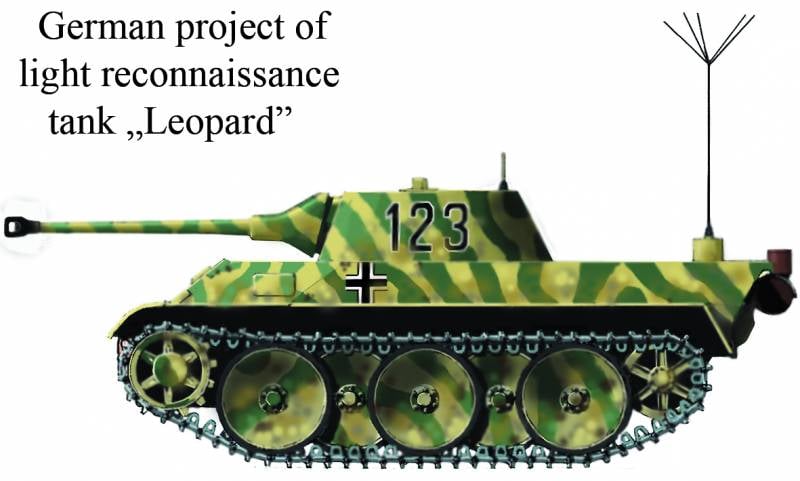
Or, for example, another strange solution. For some reason, during the whole war, Hitler’s designers, with persistence worthy of a better application (and I recall a monstrous lack of resources!), All the time tried to create a good reconnaissance tank. Models followed one after another, including this 1944 model under a promising chassis. The tank was called the Leopard, and he was perfect in every way. That's just the time of such tanks irretrievably gone, not to mention the purely technological difficulties in the production of many different chassis!
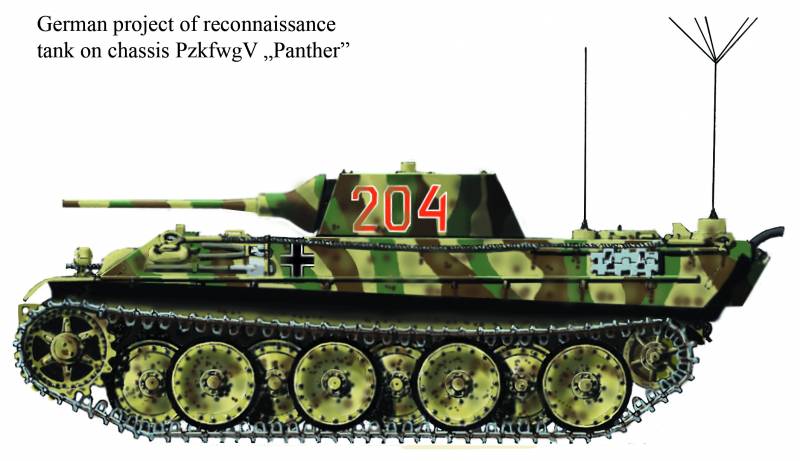
And imagine, the Germans understood this, and made a reconnaissance tank based on the Pzkfwg V Panther tank. And what did you get? That's right, a worsened version of the Panther!
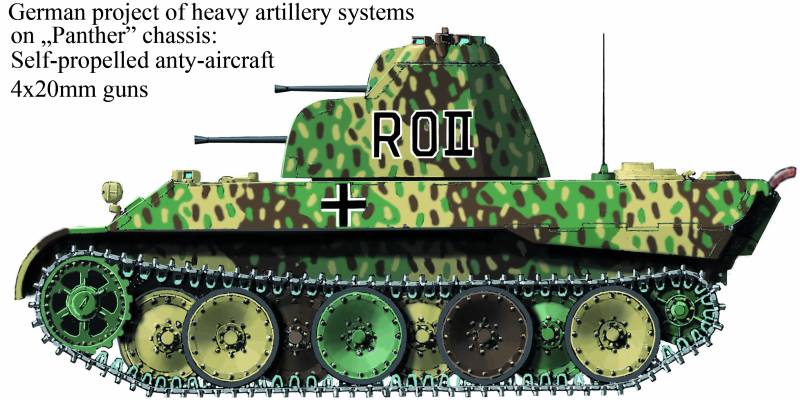
But, having a Panther chassis, they decided to launch an anti-aircraft tank with four 20-mm anti-aircraft guns at once. But they usually didn’t have enough of the usual Panthers, and then they’d spend money on anti-aircraft ...
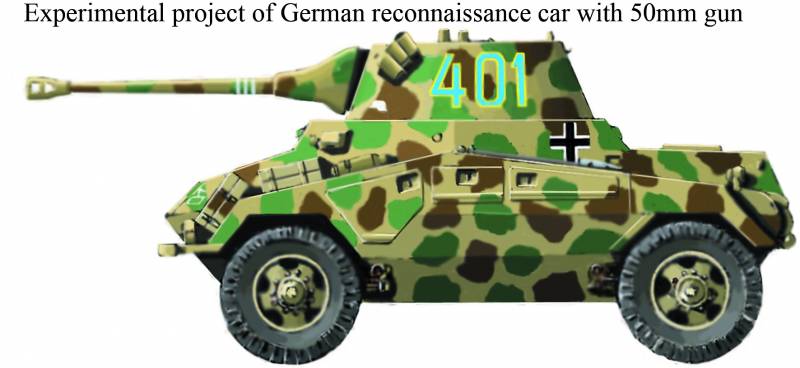
By the way, the Germans liked the tower with the 50 mm cannon from the Leopard reconnaissance tank so much that they put it on this wheeled chassis: VsKfzg 261. What if they were lucky with it? Bad luck…
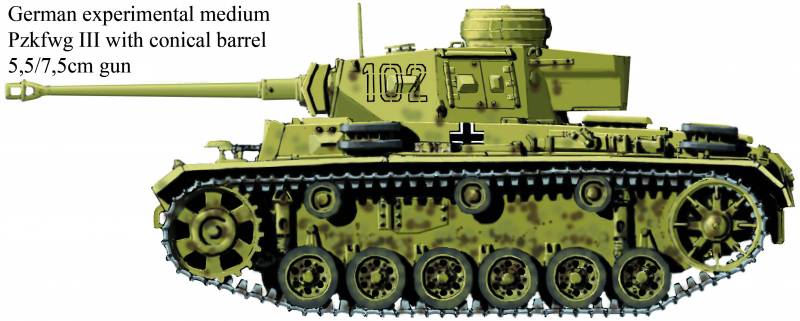 One of the attempts to improve the armament of serial tanks, in particular, the Pzkfwg III Ausf L, was to install bicaliber 55-75-mm guns with a conical bore on it
One of the attempts to improve the armament of serial tanks, in particular, the Pzkfwg III Ausf L, was to install bicaliber 55-75-mm guns with a conical bore on itIt seems to be "murderous" happened weapon, however, it turned out that tanks are more likely to fight with enemy infantry than with tanks. Therefore, they need a powerful high-explosive shell. But this tool didn’t have it, and besides, it needed shells with tungsten alloy cores, and the whole tungsten was ... in the bowels of the Ural Mountains. And it turned out that nothing came of the idea to rearm the new Pzkfwg III gun !!! Were simply lost strength, time and money! By the way, the Soviet T-34 tanks with "anti-tank" 57-mm cannons also did not show themselves in the toy, although they shot perfectly at enemy tanks at the firing range!
But this is our "prayer for the cup", which could be called so: "New medium tank, come, come!" How many forces were thrown during the war by the team of J. Y. Kotin to create the KV-13! A topic worthy of a separate book. In what variants it was not offered: with a 76-mm cannon, and with a 122-mm howitzer, which was to shoot at the tanks with a cumulative projectile. But all the main technical solutions were old. Including the "corporate" fracture of the front armor plate. As if you could not just take and copy it from the same T-34! To make the hull wider, to put an expanded shoulder strap under the tower, to make the tower itself triple, to place the commander’s turret on it, like the Germans’s, and to position the engine across, like on the failed T34M, and it would have turned out to be a really new tank (see the figure below), not just another lightweight KV. But something was not enough for the designers. Well, failures in the creation of new types of BTT have been with us ...
This completes the inspection of our tank panopticon.
PS The site administration and the author thank A. Sheps for the beautifully executed illustrations provided by him for our tank panopticon.
- Vyacheslav Shpakovsky
- Our tank panopticon: T-34, which were and which could be
Monsters in armor
"Goblin Reserve." Tanks in layouts and pictures
Tank panopticon
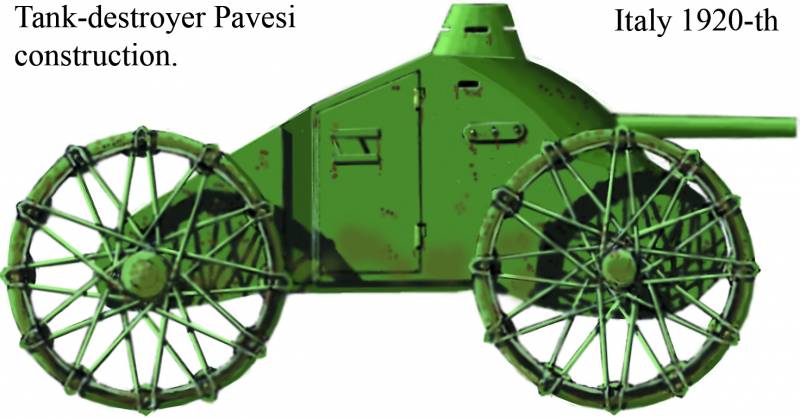
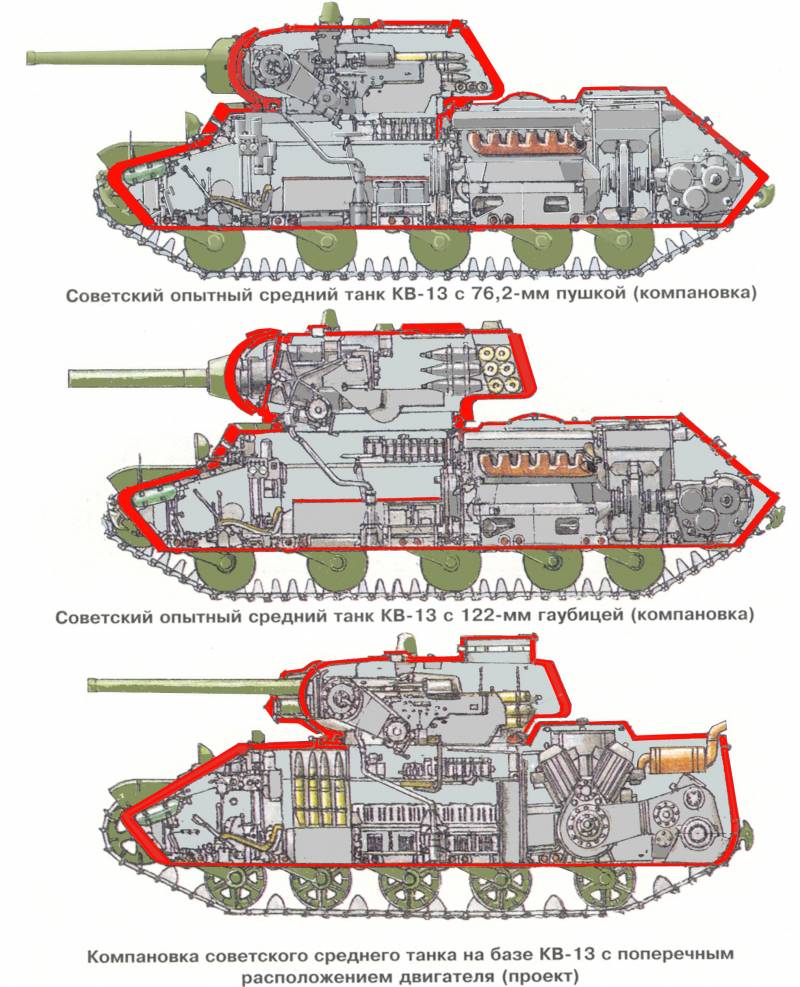
Information